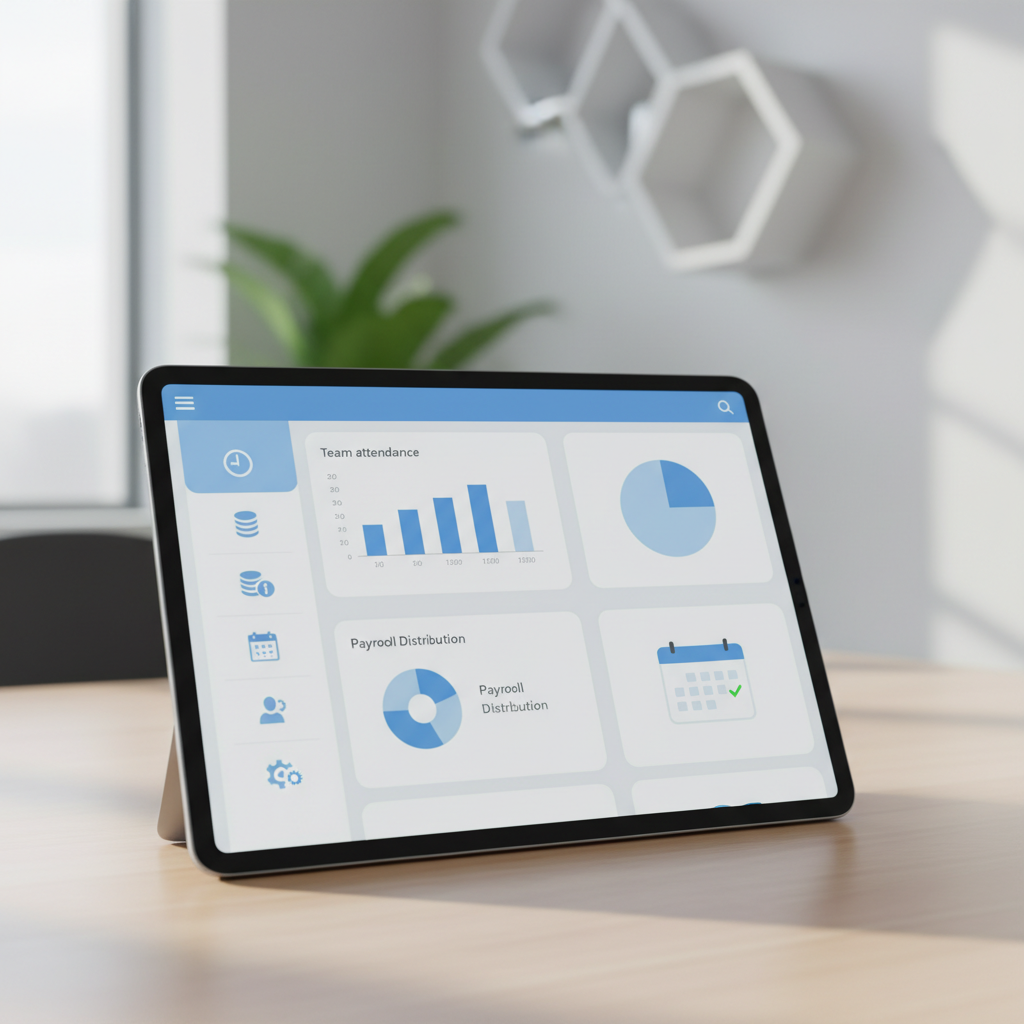
Table of Contents
Introduction
Let’s be honest—managing HR manually is exhausting. Between tracking employee data, juggling attendance records, wrestling with payroll, and staying on top of compliance requirements, it’s enough to make anyone’s head spin. But here’s the thing: it doesn’t have to be this complicated. HR management software has become a game-changer for businesses of all sizes, transforming these headache-inducing tasks into smooth, automated processes. Picture this: a single platform that handles everything while you focus on what really matters—growing your business and supporting your team.
Here’s why this matters more than you might think. As your business grows (and hopefully it will), those manual HR processes start breaking down. Errors creep in. Deadlines get missed. Compliance becomes a nightmare. A solid HR software solution changes all of that by keeping employee records secure, tracking time and leave accurately, and making payroll feel less like rocket science. You know how investment portfolio management software helps investors make sense of complex financial data? HR software does the same thing for your people operations—it brings order to chaos and gives you the insights you need to make smart decisions.
Now, let’s talk about flexibility. Cloud-based HR solutions have become incredibly popular, and for good reason—you can access everything from anywhere, anytime. Your remote team members can clock in from their home office, managers can approve time off while traveling, and you can run reports from your phone. It’s similar to how smart investors think about long-term versus short-term investing strategies—you want tools that adapt to your changing needs. On the flip side, some companies prefer on-premises solutions for tighter security control or specific regulatory requirements. The choice is yours, and that’s what makes modern HR software so appealing.
But here’s where it gets tricky: choosing the right software. It’s not just about features (though those matter). You need to consider your company size, budget reality, and whether the vendor will actually support you when things go sideways. Think of it like planning any major business investment—you wouldn’t buy expensive equipment without understanding the total cost, right? The same logic applies here, much like how you’d carefully consider budgeting techniques for any significant expense. Plus, when you’re dealing with sensitive employee data, vendor security and reliability aren’t just nice-to-haves—they’re absolutely essential.
What You’ll Learn in This Guide
We’re going to walk through everything you need to know about HR management software, from the basics to the decision-making process. Whether you’re running a small business or managing a growing team, this guide will help you cut through the noise and find software that actually works for your situation.
- Overview of HR Management Software: We’ll start with the fundamentals—what this software actually does, why businesses can’t seem to live without it anymore, and how it transforms your daily HR headaches into manageable tasks.
- Key Features to Look For: You’ll discover the must-have features like employee data management, time tracking, payroll automation, and benefits administration that separate good software from great software.
- Benefits of Adoption: We’ll show you the real-world impact—how the right software saves time, eliminates errors, keeps you compliant with labor laws, and gives you the accurate data you need to make better decisions.
- Choosing the Right Software: Finally, we’ll give you a practical framework for evaluating your options based on your company size, budget constraints, deployment preferences, and the level of support you’ll actually receive.
Ready to dive in? Each section builds on the last, giving you a complete picture of what’s available and how to make the best choice for your business. Along the way, you might find it helpful to understand related business topics—like how to read financial statements—since effective business management requires understanding multiple moving parts. As HR technology continues to evolve at breakneck speed, getting this right now will set your business up for long-term success.
Here’s something important to remember: HR software isn’t just about efficiency (though it delivers that in spades). It’s about creating a better experience for your employees and giving you the tools to build a stronger company culture. Good HR systems improve communication, boost employee engagement, and provide the real-time insights that help you make decisions based on data instead of guesswork. We’ll also explore whether you need an all-in-one solution or if specialized tools might work better for your specific needs.
So buckle up—we’re about to transform how you think about managing your most important business asset: your people. By the time we’re done, you’ll have everything you need to choose HR management software that doesn’t just work, but actually makes your life easier. Let’s get started on this journey toward smarter, more efficient HR processes that will free up your time for what really matters.

Let’s talk about something that’s probably keeping you up at night if you’re running a business: managing your people. You know what I mean—tracking who’s in, who’s out, making sure everyone gets paid correctly, and somehow keeping up with all those HR regulations that seem to change every other week. Here’s the thing: you don’t have to do this the hard way anymore.
HR management software isn’t just some fancy tech buzzword. It’s your secret weapon for turning chaos into order. Think about it—when was the last time you spent hours manually calculating payroll or hunting down attendance records? If that sounds painfully familiar, you’re not alone. Smart companies are ditching the spreadsheets and paper trails for software that actually works with them, not against them.
What makes this even better? You’re not just saving time (though you’ll save tons of it). You’re building a foundation that lets your business grow without the growing pains. When you can manage employee data, track attendance, handle payroll, and stay compliant with the click of a button, you’re free to focus on what really matters—building a team and growing your business.
Key Features of HR Management Software
Here’s where things get interesting. Modern HR software doesn’t just do one thing well—it’s like having an entire HR department that never sleeps, never makes mistakes, and never calls in sick.
At the heart of it all? Your employee database. But we’re not talking about some dusty filing cabinet here. Picture a system that knows everything about your team—contact info, work history, performance reviews—and can pull up any detail in seconds. That’s the foundation everything else builds on.
Now, let’s talk about attendance tracking. Remember those old punch cards? (Maybe you’re still using them—no judgment.) Today’s systems let employees check in from their phones, track their hours automatically, and handle leave requests without you having to play referee. Managers get real-time visibility into who’s working when, and employees get the flexibility they actually want.
But here’s where it gets really good: payroll automation. No more late nights double-checking calculations or worrying about whether you missed someone’s overtime. The software handles salary calculations, deductions, taxes—the whole nine yards. Your people get paid accurately and on time, every time.
Want to dive deeper into tracking capabilities? Check out this guide on software for time tracking that works hand-in-hand with attendance management.
The real game-changer? These systems don’t just track data—they help you make sense of it. Built-in analytics show you patterns you never noticed before. Compliance management keeps you on the right side of labor laws without you having to become a legal expert overnight. And with mobile access, your employees can update their own info, request time off, and check their pay stubs without bothering HR for every little thing.
Cloud-based options take this even further. Your data is accessible anywhere, scales with your business, and doesn’t require a massive upfront investment. It’s part of a bigger shift toward Software as a Service (SaaS) models that make powerful tools accessible to businesses of all sizes.
Key Aspects of Key Features
Let’s break this down into bite-sized pieces so you can see exactly what you’re getting:
- Employee Information Management: Think of this as your digital filing cabinet, but smarter. Everything about your employees lives in one secure place—contact details, employment history, performance reviews, certifications, you name it. Need to pull a report for compliance? Done in minutes. Worried about data security? These systems use bank-level encryption to keep sensitive information locked down tight.
- Attendance and Leave Tracking: Say goodbye to timesheets that look like they’ve been through a blender. Modern tracking works in real-time, whether your team is clocking in with biometrics, mobile apps, or web browsers. Leave requests flow through approval workflows automatically, and everything syncs with payroll. No more guessing games about who’s worked how many hours.
- Payroll and Benefits Administration: This is where the magic happens. The system takes attendance data, factors in bonuses and deductions, calculates taxes, and produces accurate paychecks. Benefits enrollment becomes a breeze—employees can sign up for health insurance or adjust their 401k contributions without paperwork nightmares. Happy employees, fewer headaches for you.
- Compliance and Reporting: Nobody wants a surprise visit from the Department of Labor. These systems generate the reports you need, when you need them. They track certification expirations, remind you about contract renewals, and keep you updated when regulations change. Think of it as having a compliance expert on your team 24/7.
Understanding these features helps you ask the right questions when you’re shopping for solutions. But features are just the beginning—let’s talk about what this actually means for your business.
Benefits of Using HR Management Software
Okay, so we’ve covered what HR software can do. But what does it actually mean for your bottom line? How does it change your day-to-day reality?
First off, you’re going to get your life back. I’m serious. When systems handle the repetitive stuff—data entry, leave approvals, report generation—your HR team can focus on what humans do best: building relationships, developing talent, and creating a workplace people actually want to be part of. That’s not just feel-good talk; it’s strategic advantage.
The accuracy factor is huge too. Manual processes = human errors, and human errors in payroll can cost you big time. Not just money, but trust. When your people know they can count on getting paid correctly every single time, that’s worth more than you might think.
Compliance becomes manageable instead of terrifying. The software keeps track of changing regulations and helps you stay on the right side of the law. No more lying awake wondering if you’re missing something important that could result in penalties.
Here’s something interesting: when employees can access their own information and handle routine requests themselves, they become more engaged. Self-service portals aren’t just convenient—they’re empowering. People like having control over their own data and not having to wait for HR to get back to them about their vacation balance.
The data insights piece is where things get really exciting. You start seeing patterns in turnover, identifying your best recruitment channels, and making workforce planning decisions based on actual data instead of gut feelings. Speaking of data-driven decisions, business leaders often find that understanding investment portfolio management software complements their overall strategic planning efforts.
Key Aspects of Benefits
Let’s get specific about what changes when you make this switch:
- Time Savings: We’re not talking about saving a few minutes here and there. We’re talking about hours every week that suddenly free up for strategic work. Data entry, leave calculations, report generation—all handled automatically. Your team can finally focus on developing people instead of pushing paper.
- Improved Data Accuracy: Human error becomes the exception, not the rule. Payroll mistakes drop dramatically. Compliance reporting becomes reliable. When your data is clean and consistent, every decision you make is built on solid ground. That confidence is priceless.
- Regulatory Compliance: The system becomes your early warning system for compliance issues. It tracks changing regulations, reminds you about required filings, and helps you maintain the documentation you need if questions arise. Sleep better knowing you’re covered.
- Enhanced Employee Engagement: When people can access their own information, submit requests, and get quick responses, they feel more in control. Transparency builds trust, and trust builds engagement. Plus, your HR team spends less time answering routine questions and more time on meaningful interactions.

Here’s the reality: HR management software isn’t just nice to have anymore—it’s become essential for businesses that want to stay competitive. We’ve walked through the game-changing features that make modern HR software so powerful, from keeping employee information organized to tracking attendance and leave without the headaches. And let’s talk about payroll automation—it doesn’t just save time, it practically eliminates those costly errors that can damage employee trust faster than you’d think. Whether you’re leaning toward cloud-based flexibility for your remote team or prefer keeping everything on-premises for tighter security control, there’s a solution that fits your company’s DNA.
The benefits? They’re pretty compelling when you break them down. Sure, automating routine tasks saves hours every week, but the real win is how these systems clean up your data accuracy. No more spreadsheet nightmares or manual errors that keep you up at night. Staying compliant with regulations becomes manageable instead of overwhelming—built-in reporting and automated reminders handle the heavy lifting so your HR team can focus on what really matters. Plus, when employees get self-service portals, something interesting happens: they feel more in control of their information, which builds trust and engagement across your entire workplace culture. The key is knowing your organization inside and out—your size, your specific needs, your budget reality—so you can choose between comprehensive all-in-one solutions or specialized tools that nail specific functions.
Ready to make your move? Start by taking an honest look at where your HR processes are struggling right now. What’s causing the biggest headaches? Which features would make the biggest difference for your team? When you’re thinking about the financial side of this investment, it’s smart to consider broader strategies like long-term vs short-term investing to frame how you approach this technology purchase. Want to get better at evaluating the financial impact over time? Learning how to read financial statements will help you track your ROI more effectively. If you’re curious about managing complex business assets (and HR software definitely counts), check out this guide on investment portfolio management software—the principles of strategic management apply whether you’re dealing with financial portfolios or human capital. And because budgeting smart is crucial for any major software purchase, proven techniques like those found in budgeting guides can help ensure your investment supports sustainable growth while you work with vendors who take data security seriously.
When you combine the right HR management solution with smart financial planning, you’re not just buying software—you’re investing in your team’s future. Digital transformation in HR goes way beyond making tasks easier (though that’s nice too). It’s about creating the foundation for better strategy and stronger company culture that drives long-term success. With the right knowledge, careful preparation, and strategic thinking, you can confidently choose software that empowers your business, protects your investment, and genuinely supports your people. The time to act is now—choose wisely, and step into a future where HR management actually works for you instead of against you.
Frequently Asked Questions
-
What is HR management software?
- A tool designed to streamline and automate human resource operations.
-
Can small businesses benefit from HR software?
- Yes, there are scalable solutions suitable for businesses of all sizes.
-
Is cloud-based HR software secure?
- Most reputable vendors offer robust security measures for cloud solutions.
-
How does HR software improve compliance?
- By automating record-keeping and updates aligned with labor regulations.
-
Can HR software integrate with other systems?
- Many solutions offer integrations with payroll, accounting, and other business software.
